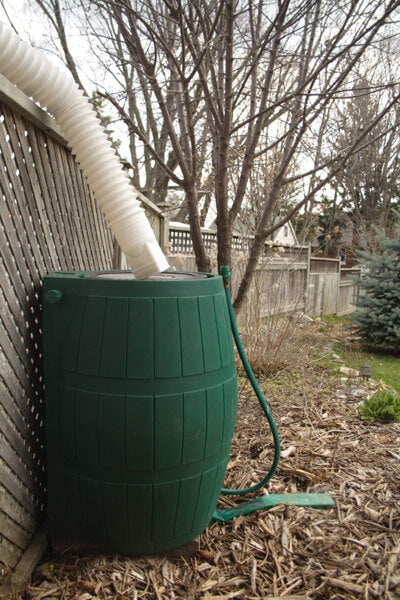All these things add up to great water savings that can keep your garden going in dry times. Remember that vegetables are about 90% water. No water, no harvest!
Use soaker hoses
Lay out a soaker hose alongside rows or through beds to deliver water gradually without waste. Soaker hoses can be damaged by sun, though, so cover them with a layer of mulch. Also keep in mind that soaker hoses are more efficient than overhead sprinkling, but not quite as efficient as drip irrigation (see next item below). In the winter, take up your hose and protect it from freezing weather, again to avoid damaging the material. It sounds odd, but the soaker could spring a leak; then too much water might ooze out in one place and keep it from moving through the entire length of the hose.
Try drip irrigation
This is a little more trouble because you have to run a tube to every plant, but it works great in small gardens and pots. The tubes and emitters deliver water where you place them (at the base of each plant) and nowhere else. Drip irrigation was perfected for agriculture in the desert climate of Israel where every drop counts — so it's no surprise that it is the most efficient method of watering.
Water in sections
Some parts of the garden may get thirstier than others, depending on the soil, amount of sun, and how the crop grows. For example, deeply planted tomatoes (two-thirds underground per Bonnie instructions) may have access to deep soil moisture while the pole beans are hurting. In this case, it helps to water the garden in sections, connecting more than one soaker hose to a distributor that provides adjustable outlets off one faucet. This lets you turn on one section and turn off another. Most soaker hoses and drip systems are sold in varying lengths.
Water deeply
Let water get way down into the soil. Frequent, shallow watering is tempting, but it's not good, as it encourages roots to stay near the surface and makes plants more susceptible to drought. It is better to water plenty (which means deeply) once or twice a week than to water a little every day. By deep watering we mean applying at least an inch of water at a time. You can measure this by placing a container where it can catch the water. When it is filled to an inch, you've applied enough. Standing in place while you water with the hose, although tempting, is not usually a way to water deeply. Time or patience usually run out and water runs off. Use soaker hoses, drip, or sprinklers.
Mulch around plants
A 2- to 3-inch layer of straw or other mulch around your plants helps keep the soil moist longer by providing a barrier between the soil and the drying effects of sun and hot air. The mulch also helps keep weed seeds from sprouting. You can mulch with straw, pine straw, homemade compost, or even sheets of newspaper (4 sheets thick). Or, use a bagged mulch such as Scotts® Nature Scapes®.
Use a timer
A timer on your spigot will turn off the flow of water without your having to depend on your memory or schedule. You can buy these at garden centers and home improvement stores at prices starting about $20. They're worth every penny, as they make it easy to have a garden and a job, too!
For the long term, improve the soil
Add lots of compost to improve soil texture. Heavy clay can hold lots of water, but it really does get as hard as a brick when it dries. So compost makes it easier on plants in heavy soil. It also helps sandy soil, which absolutely does not hold water. Sand is actually tiny grains of rock that are impervious to water, so adding compost, which sponges up moisture, increases the ability of a sandy soil to hold water from the hose or the heavens. If you don't have a compost pile going, it is never too late to start one. You can also buy bagged mushroom compost (a byproduct of mushroom farms) that makes a good soil additive.
Collect water in rain barrels
You can buy official rain barrels with spouts or you can fashion your own from many types of barrels or large containers. Use these to collect water from gutter downspouts or other areas where water runs and is easily collected, then save the water for a not-so rainy day. Just be sure that whatever container you use can't be reached by small children, and place screening over the opening to keep mosquitoes and litter out.
For more great ideas, check out these drought-busting techniques from fellow Bonnie gardeners.








 Herbs
Herbs
 Vegetables
Vegetables
 Fruit
Fruit
 Flowers
Flowers
 Succulents
Succulents


